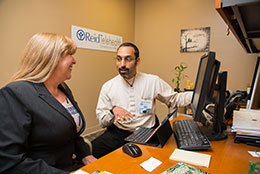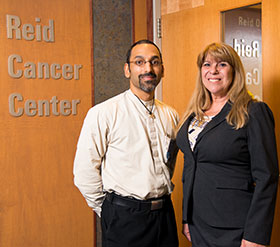The Healing Power of Yoga
Faculty member, oncologist research how Complementary and Alternative Medicines are a tool in the arsenal to fight disease
When Ange Cooksey was diagnosed with cancer in December 2014, she turned to yoga to help deal with the side effects and stress of treatment. Cooksey had been practicing yoga for 40 years, including as part of her treatment regimen for her Type One Diabetes. Today, yoga has an even greater purpose in her academic research and her life.
Cooksey is a senior lecturer in humanities at IU East, specializing in the philosophy of Eastern and Western religions and death and dying. She spent her sabbatical in spring 2011 researching death and dying, which led to the development of a biomedical ethics course that is now part of IU East’s new Bachelor of Applied Sciences degree program established in August 2015.

IU East Senior Lecturer in Humanities Ange Cooksey and Dr. Jeevan Sekhar, an oncologist at Reid Health, discuss their research on Complementary and Alternative Medicines.
In her first meeting with her oncologist, Dr. Jeevan Sekhar at Reid Health, the two found that they had a mutual appreciation for Complementary and Alternative Medicines (CAM).
“I had an idea for a project for an integrated medicine institute at Reid. When I met Professor Cooksey, on a professional level as she was my patient, she expressed the fact that she is an avid yoga practitioner and was pursuing her certification in yoga. With yoga being an integral part of my idea for the institute, I threw it out there to see if she would be interested in potentially collaborating and she said yes,” Sekhar said.
As patient and doctor, Cooksey and Sekhar discussed the use of CAM alongside traditional medicines and how the practice could better help all patients if readily available.
“We talked about how CAM was gaining some foothold in the cancer community and we have both been studying its use,” Cooksey said. “Jeevan and I developed a partnership to research CAM with a specific interest in looking at trials and studies. Our research is grounded in current yoga practice and hard scientific evidence that it works to help patients to heal. The gestures and positioning in yoga helps patients to reduce inflammation, nausea, fatigue and many other symptoms to make measurable improvements,” Cooksey said.
While undergoing treatment, Cooksey relied on yoga to relieve symptoms of radiation for breast cancer.
“I call it the necessary consequences of treatment – the nausea, fatigue, etc. – that you experience while going through radiation or chemotherapy. Yoga is to help heal by releasing the lymph, gently stretches the compressed organs and stretches the muscles to help release all the chemicals and to address some of the main complaints of treatment,” Cooksey said. “Yoga is not a replacement for conventional medical treatments such as radiation or chemotherapy.”
In addition to the benefit she received from practicing yoga for herself, Cooksey wanted to share it with others. She is now a certified yoga instructor and completed special training to help cancer patients. Each week, she volunteers to work with three women who have been diagnosed with cancer. It’s her way to contribute and give back to others while learning more about yoga as an alternative treatment to cancer.
“I teach them about yoga and what can be helpful to them to build a tool kit to best address their symptoms on any given day, because every day is different,” Cooksey said. “When you are first given that cancer diagnosis, you feel like you have lost control. By using yoga and working with each of these beautiful women, I feel like we can say – at least while we are on that mat – that we are in control.”
Sekhar said CAM is another tool in the arsenal toward enhancing the quality of life for patients. The use of CAM has been shown to decrease anxiety and improve well-being among many other beneficial health qualities, he added.
“Ange was integral in helping get a lot of the research done for the original proposal to give to Reid and cultivating a lot of that information so we could come up with a solid basis to launch the program on,” Sekhar said. “Right now, as far as the research project is concerned, we’re reviewing the current research in order to develop protocols through which we can further the study of CAMs in a wide variety of disease states, including cancer, and to eventually advance the field of CAM in an integrative medicine.”
Sekhar and Cooksey have completed the first phase of their research, gathering and reviewing medical studies related to CAM. They are now in the second phase, in which they have selected a few studies to further research the connection of complimentary therapy and examine the effectiveness yoga and its abilities to help patients cope with their treatments.
“IU East and Reid Health have really supported the great work we hope to accomplish in the future. Our collaboration is so valuable because Jeevan brings this other intuitive vision to these complimentary therapies we wouldn’t have otherwise,” Cooksey said.
Mary Blakefield, interim vice chancellor for Academic Affairs at IU East, said she is constantly amazed by the richness of the collaborations that occur almost spontaneously between faculty and various community organizations.
“Collaborations, both formal and informal, allow IU East to serve the community as a resource, as an advocate and as a leader,” Blakefield said. “Ange’s positive energy and enthusiasm for her discipline of philosophy has evolved into the study and research of complimentary medicines. I am amazed and incredibly pleased that the study and practice of yoga was able to create the synergy to establish another positive link between IU East and Reid Health.”
While Cooksey and Sekhar agree there are benefits to complimentary therapies, they want to asseverate that it should be used in partnership with conventional medical treatments.
Sekhar said, “My interest stems from the fact that it is presumptuous to think that any one paradigm has all the answers. Personal experience with using different medical maladies for ailments that I have, mainly back pain, and the use of some yoga and acupuncture to help with that demonstrated to me the power of complimentary therapies. But similarly, complimentary therapies are essentially what they are, they’re complimentary. No field or medical paradigm, be it a traditional Western model or an Eastern model, has all of the answers. So integrating all of those could really optimize both health maintenance, wellness and disease management.”
The next step with this project will be to create a conceptual framework for the context of a coordinated center where integrative medicine could be accessed appropriately, safely based on sound evidence for effective medical care, Sekhar said. That could include one place that patients would have access to yoga, acupuncture, Tai Chi and Qigong, art therapy, massage therapy, and nutrition with a focus on diet and exercise maintenance.
And for Cooksey, she sees the research as a “marriage” of East and West as what began as a yoga practice comes full circle to impact her teaching in Western Philosophy. “I see this work bringing together the philosophy courses in logic and Western religion and those in Buddhism and Hinduism, with the ultimate goal of creating new content for IU East in biomedical ethics.
“I have taken what I have learned to lessen the physical symptoms of a medical treatment. I find that exciting. We’re experiencing that cutting edge of therapy where it meets practice. And that’s right where we want our students to be,” Cooksey said.


